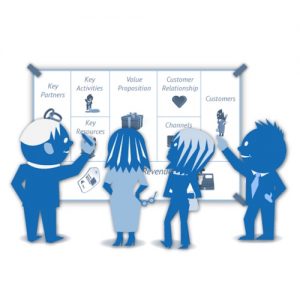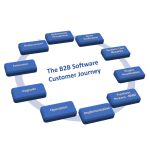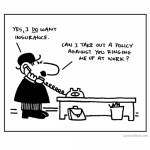Is Cold Calling Really Dead? – Part 2
 In my recent post under the title “Is Cold Calling Really Dead?” I promised more examples of companies where cold calling plays (or played) a significant and successful role in growing revenue, market share, and company value.
In my recent post under the title “Is Cold Calling Really Dead?” I promised more examples of companies where cold calling plays (or played) a significant and successful role in growing revenue, market share, and company value.
Today’s example doesn’t exist anymore. The firm (let’s call them Tangeryne) was acquired by one of the big players in their industry. A revenue generation process with cold calling as the core component was the secret to the company’s success.
The situation
Tangeryne provided an IT-security solution to a risk and a challenge that all companies have. The solution was delivered in a SaaS format and paid through a subscription.
Initially, they sold to large companies expecting big orders, only to find that the sales cycles were long and expensive. A call-center, which helped the company with appointment booking, suggested trying to sell to the SMB-market directly over the phone.
The assumption was that IT-managers in SMB companies:
- could be reached over the phone,
- would easily understand what the solution did
- could make a purchase decision without needing the approval of anyone else
- wouldn’t haggle so much and therefore yield a better gross margin.
Testing the approach
The first tests assumed that a subscription could be sold in the first call. That turned out not to be the case. And it remained difficult even in the second and the third call, too.
Then Tangeryne tested an assumption that a potential customer would be willing to accept a free trial.
Bingo.
Over a 14-day test period the solution would gather an adequate amount of data, allowing the follow-up-call, aimed at closing the business, to be based on a review of how the solution performed for the potential customer, all using customer data.
The conversion rates were very promising.
Bringing the sales process in-house
The Tangeryne founders decided to build an in-house call center and started to hire salespeople. They also hired an operational sales manager, responsible for managing and coaching the salesforce on a daily basis.
The approach worked, and revenue grew rapidly.
Refining the approach
They quickly realized that not everyone was equally good at selling over the phone. They engaged external coaches that helped the salespeople improve their productivity.
That made a significant overall improvement, but there was still a huge variance in performance across the sales force.
Qualification
The best-performing (top 10%) salespeople had certain qualities:
- They made more calls than the average salesperson
- They did that because they were faster at disqualifying potential customers that they assessed were not interested in signing up for a free trial (this way they freed up time to make more calls).
- They could make the potential customer feel comfortable and thereby prepared to discuss the benefits of the solution.
- They were better at closing at all stages of the process, but it was hard to nail what made the difference.
The downside of being successful
 To scale the business Tangeryne needed to add more salespeople, continuously.
To scale the business Tangeryne needed to add more salespeople, continuously.
That proved to be very difficult.
Getting enough applications was the first challenge. They engaged with temp agencies and an array of recruitment companies that provided hundreds of candidates.
The second challenge was predicting who, among the candidates, would become successful (after product and sales training). That was very hard.
Tangeryne decided to pay the applicants for participating in a full two-day test. Applicants were given a brief introduction to the products and the sales process. Then they were given a phone and a call list. Calls were made while coaches and sales managers listened in.
This procedure improved the predictability substantially, but many applicants were reluctant to spend two full days even when they received compensation. Unemployed candidates were readily prepared to set aside two days, while candidates with jobs found it difficult.
Breaking up the process
 Facing difficulties recruiting enough talent, Tangeryne management now started breaking up the sales process. The idea was to improve the productivity across the sales force in addition to improving the productivity of each individual.
Facing difficulties recruiting enough talent, Tangeryne management now started breaking up the sales process. The idea was to improve the productivity across the sales force in addition to improving the productivity of each individual.
There were four steps in the sales process:
- Getting through to an IT manager (by far the most time-consuming part of the process)
- Gaining acceptance of a trial
- Making sure the trial was executed (required some action on the part of the prospects)
- Converting the trial to a subscription
(There were also renewals and upselling that this post will not deal with).
Step 1 to 3 was assigned to rookies and salespeople with low performance.
Step 4 was assigned to the top salespeople.
That improved overall sales performance, but it was hard to keep people in step 1 – 3, even when they were well remunerated.
In general, it proved hard to keep salespeople for a longer period. Making outbound sales calls on the phone is not a career path that many people choose. The average tenure was 18 months.
The conclusion
 Tangeryne’s success was based on a revenue generation process where cold calling was the core component.
Tangeryne’s success was based on a revenue generation process where cold calling was the core component.
Could alternative revenue generation approaches have led to the same result?
Maybe, but that was never tested.
Was it a walk in the park?
By no means. It required a substantial investment in recruitment, skills development, and motivational instruments to keep up the spirit and productivity of their talent.
Cold calling will always have a significant amount of rejection. Such rejection is perceived to be much more personal than when someone doesn’t open your email or read the whitepaper you submitted.








